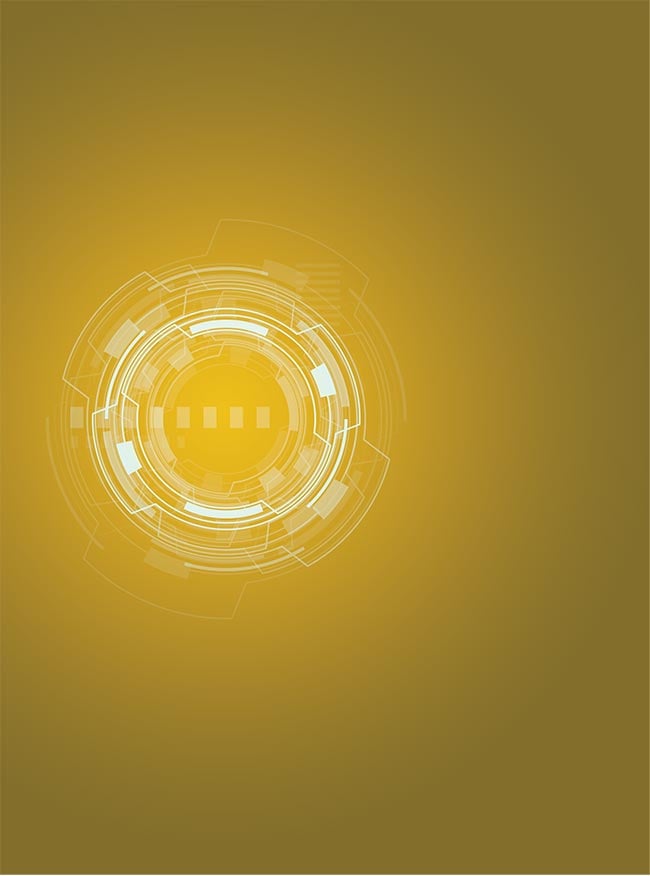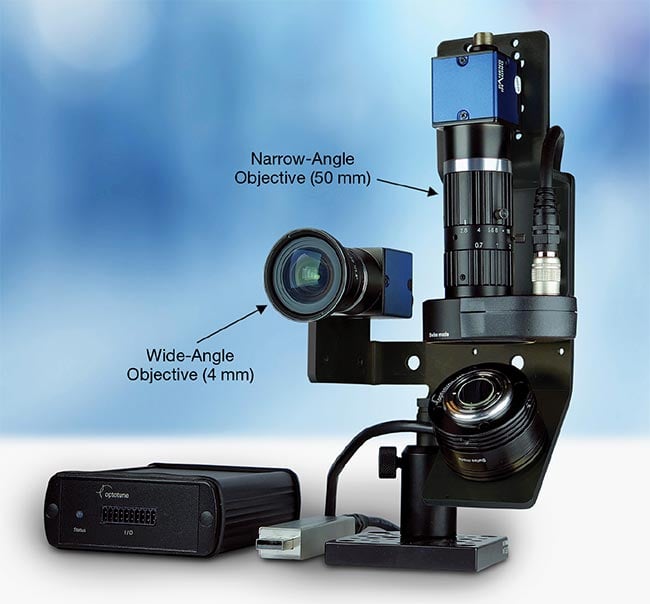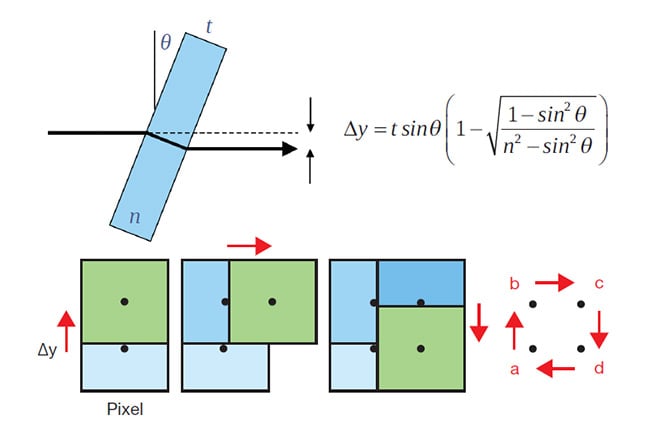Vision systems often face limitations related to wear and misalignment. Liquid optics provides a solution with unmatched flexibility, speed, and precision.
TOMAS ZVOLENSKY AND MARK VENTURA, OPTOTUNE
The remarkable capabilities of human vision serve as a powerful inspiration to developers of advanced optical systems. Despite its seemingly uncomplicated design, comprising a single lens and offering about ~1 MP of resolution per eye, human vision achieves exceptional performance. For this reason, designers and engineers strive to replicate and even surpass its capabilities.

Courtesy of iStock.com/tein-studio.
Yet while the capabilities of human vision provide a dynamic reference, creating vision systems that deliver high magnification, small pixel sizes, and low f-numbers — especially in low-light conditions — poses substantial challenges. These factors tend to reduce the depth of field, necessitating precise focusing solutions. Traditional mechanical lenses often suffer from misalignment and wear over time, making them less reliable for high-speed, high-frequency applications.
Liquid lenses offer a compelling solution to overcome these bottlenecks. Drawing on the dynamic focusing capabilities of the human eye, these lenses, constructed with a polymer membrane encasing optical fluid, adjust focus rapidly through a voice coil actuator (Figure 1). This mechanism pumps liquid in or out, altering the lens shape from convex to concave to achieve focus adjustments within milliseconds. Moreover, this technology enables reliable, precise focusing without mechanical wear and tear, and guaranteed performance for a billion refocus cycles and beyond.

Figure 1. The anatomy of liquid lenses (left) and actuation principle. Courtesy of Optotune.
Precision and focusing speed
Liquid lenses are integral elements of various vision systems, including those that are used in established applications in microscopy, industrial code readers, and even consumer electronics, such as smartphones. Also, these lenses excel in applications that require rapid refocusing, such as inspection systems for integrated circuits, connectors, and other small components. Optimal performance is typically achieved when liquid lenses are incorporated into the lens stack, ideally behind the aperture stop to maximize low f-number performance and large image circles. Liquid lenses are available in numerous configurations, covering a wide range of sensor formats and focal lengths, between 5 and 300 mm, and magnifications from 0.15× to 6×.
Delivering a current, often using inexpensive voice coil motor driver integrated circuits, with interfaces such as I2C, is used to obtain control over liquid lenses. Advanced control systems with Ethernet, USB, or analog interfaces are also available, and these options facilitate integration into various applications. Closed-loop autofocus systems can achieve focus within a few hundred milliseconds, and sensors with phase detection autofocus enable even faster, single-step focusing.
Expanding FOV: Fast steering mirrors
Conventional methods for expanding the field of view (FOV), such as short focal length lenses or large image sensor systems, are often restricted by resolution, cost, and reliability. Mechanical scanning can be slow and prone to failure. Optical zoom systems are typically bulky and compromise optical quality.
Fast steering mirrors offer a solution, enabling the rapid scanning of high-resolution images across large fields of view. These mirrors can tilt along two axes, providing an expanded FOV of up to 100°. They are also more compact than traditional galvanometer mirrors and larger than microelectromechanical systems (MEMS)-based scanners, which enables these components to strike a balance between size and performance.
Fast steering mirrors typically have a clear aperture of 15 mm, or ~0.59 in. This value is much larger than MEMS-based scanners, and, due to the single point of rotation, they are still more compact than a pair of galvanometer mirrors. The point of rotation can be placed either on the mirror surface, avoiding image shifting, or in the center of mass, to make the unit resistant to shock or vibration. The mirror is current-controlled and includes an optical feedback system for high repeatability. Small steps of 0.1° take 3 ms, and large steps of 20° settle in 13 ms.
In a typical setup, a 3-MP camera with a 75-mm (~2.95-in.) lens can achieve an angular field of view of about 4° × 5°. The mirror can expand the field ~350× to cover a total of 70° × 100° at a resolution of >1 GP. With performant hardware, and assuming an image overlap of ~20%, the time to acquire such an image stack is in the order of 10 s. Figure 2 shows a gigapixel imaging kit, comprising a wide-angle camera and a narrow-angle camera, which uses a liquid lens and a fast steering mirror.

Figure 2. A gigapixel imaging kit, comprising a wide-angle camera and a narrow-angle camera, which uses the liquid lens for focusing and a fast steering mirror to expand the field of view to 100°. Courtesy of Optotune.
Applications of fast steering mirrors
include surveillance, in which high resolution is necessary for face or object recognition, as well as iris recognition, code reading over large areas, and high-magnification imaging including on drones. In infrastructure inspection, for example, the 2D mirror is faster, lighter, and more compact than mechanical gimbals that have historically been used for these types of applications.
Medical imaging is among the additional application areas that use fast steering mirrors. These components can further enhance medical imaging by
allowing for the rapid scanning of tissues in systems such as optical coherence tomography. This in turn can lead clinicians to make faster and more accurate diagnoses.
Pixel shifters enhance resolution
Pixel shifting enables cameras to achieve higher resolution without the need for smaller, noisier pixels, which are also apt to demand more expensive optics. This technique uses small, controlled movements to oversample an image, effectively increasing its resolution. In this way, pixel shifting is comparable to the functionality of the microsaccades of the human eye.
Pixel shifters are particularly useful in thermal cameras, in which pixel sizes are difficult to reduce to <15 µm. By shifting the image in small increments, pixel shifters can double the effective resolution to provide clearer, more detailed images (Figure 3, top). As such, this technology is beneficial for applications such as display inspection, microscopy, and slow-moving object surveillance, in which high resolution is critical.

Figure 3. The working principle of pixel shifters: The tilt angle of a glass window is accurately controlled along the x and y axes (top left) such that the image is shifted by half a pixel, or a full pixel, in the case of color cameras with a Bayer pattern. Courtesy of Optotune.
A glass window, which serves to move the image in small, precise increments, is typical of most pixel shifting. This method can significantly enhance the resolution of color, monochrome, and thermal imagers. However, it requires synchronization with the camera’s frame rate and increases computational demands. It is therefore best suited for applications in which the need for high resolution outweighs the need for rapid frame rates.
Application considerations
The integration of liquid optics offers particular promise for quality control and inspection processes in the realm of industrial automation. Since liquid lenses rapidly adjust focus and adapt to varying object heights and distances, these optics are invaluable in environments where speed and precision are paramount.
In assembly lines, where components
of varied sizes and shapes must be inspected, liquid lenses can instantly switch between focal points. This ensures that every item is examined with the level of clarity necessary to meet stringent requirements for accuracy and reduce
the likelihood of unnoticed defects. Moreover, the application of fast steering mirrors in machine vision systems
enables quick scanning of large areas. This quality is critical to accelerate processes such as wafer inspection in semiconductor manufacturing in which the slightest imperfection can lead to costly failures.
Liquid lenses also swiftly alter focal lengths. This enables the creation of more versatile and portable imaging devices and offers advantages in the medical
sector. For example, liquid lenses are used in advanced retinal imaging systems,
allowing ophthalmologists to perform more detailed and rapid eye examinations. The adaptability of these lenses can further lead to the development of hand-held diagnostic tools that could be used in
remote or under-resourced areas, providing high-quality medical imaging without the need for bulky equipment.
The European Union Commission-funded project iToBoS (Intelligent Total Body Scanner for Early Detection of Melanoma) is one example of how liquid lenses were used in a device that improves the early detection of melanoma. This project’s aim is to develop an AI diagnostic platform for the early detection of melanoma based on a total body scanner that is powered with high-resolution cameras equipped with liquid lenses.
Liquid lenses are viable in the consumer electronics industry, too, particularly in augmented reality (AR) headsets. They enable cameras to achieve quick and precise autofocus, which is crucial for capturing high-quality images and videos in varying environments. As AR technology evolves, the need for compact, responsive optical components will grow. Liquid lenses and fast steering mirrors could be used to achieve lightweight, high-performance AR glasses that provide users with a seamless blend of digital and real-world visuals. These technologies could also lead to more immersive virtual reality (VR) experiences by enabling headsets to offer dynamic focusing and wider fields of view, enhancing the realism of virtual environments.
And in defense and security, liquid optics are positioned to play an essential role in improving surveillance systems and targeting mechanisms. Quickly adjusting focus or expanding the FOV offers significant benefits in rapid response scenarios, such as in drones used for reconnaissance missions. Fast steering mirrors can be used in advanced imaging systems to provide a broader situational awareness, enabling the detection and tracking of objects across large areas
with high precision. These technologies could also enhance the capabilities of night vision and thermal imaging equipment, providing clearer images under challenging conditions and improving
the effectiveness of security operations.
Paradigm shift across industries
As liquid optics technologies continue to advance, their broader implications across various industries are increasingly apparent. By offering unmatched flexibility, speed, and precision, these technologies are enhancing current applications and paving the way for future innovations.
Even beyond imaging applications,
liquid lenses and 2D mirrors are also
applied in several laser-based applications. These include 3D marking, laser-based welding and/or cleaning, cosmetic treatment, and beam stabilization for terrestrial and satellite free-space communication.
Meet the authors
Tomas Zvolensky is marketing manager at
Optotune (Slovakia). He has more than
15 years of experience working in deep technology; email: [email protected].
Mark Ventura cofounded Optotune in 2008 and serves as vice president of sales and marketing for the company, with additional focus on product management; email: [email protected].